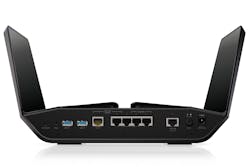The all-digital version of the world’s largest electronics exhibition kicked off today with about 1,000 vendors – down from 4500 – but offering significant technologies to industrial security, public safety, and smart space developers.
The Consumer Technology Association (CTA) recreated CES using Microsoft Team’s virtual conference technology with exhibitors listed online and attendees building a virtual agenda from companies and their microsite “panels.” More than 100 hours of streaming content and communication functionality will be open for 30 days after the event concludes on Thursday.
According to Gary Shapiro, CTA’s CEO and “ninja innovator,” the primary trendsetting consumer-focused technologies are in 5G infrastructure needed to support broadband streaming services, 8K TVs, AR, VR, health tech and UAS (drones). For industry, the top CES 2021 trends to watch include are 3D cameras, 5G, AIoT, biometrics, smart locks, drones and WiFi 6E. Here’s a closer look:
3D Cameras and LiDAR
A CES 2021 honoree, the Kandao Obsidian Pro is a professional 360 camera with eight APS-C sensors, capable of delivering a 12K 3D 360 stream at 30fpsThe ability of a 3D camera system to observe, inspect, and scrutinize objects with depth of field (DoF) is gaining traction in pandemic entry screening, automotive screening, food, pharmaceutical, machine vision use cases and event security. As I reported at last year’s CES, the use of LiDAR in small 3D DoF cameras delivers a wireframe “image” that preserves privacy, yet identifies a face, even one partially obscured by a mask or PPE.
Just prior to CES 2021, several reports surfaced that Apple will adopt LiDAR technology on "all 2021 iPhone models" and Samsung will as well on multiple Android platforms, confirming the increase in LiDAR adoption as a “Facial Authentication” and object recognition sensor.
The Intel RealSense ID combines active depth with a neural network, a dedicated system-on-chip and embedded secure element to encrypt and process user data. Using deep learning, it adapts to users over time as they change physical features, such as facial hair and glasses or appear in different lighting conditions.
5G
5G network rollouts from Verizon, T-Mobile, and AT&T continue, and industrial applications continue to have an impact on the economy. 5G-enabled corporate campuses, schools, fulfillment centers, manufacturing, critical infrastructure, agriculture equipment, UAS, autonomous vehicles, facility perimeters, borders, smart spaces, biometric screened entries, are all use cases where wireless infrastructure investment will be paid back through economic expansion and the necessity of connectivity in a pandemic.
5G-enabled solutions satisfy a very high demand for data and millimeter wave to deliver gigabit wireless services. Qualcomm and Intel technology introductions continued at CES 2021 in the form of new low-power chipsets and wireless equipment.
Security integrators have unique opportunities where 5G build-outs are happening, and the CES 2021 carriers presented an array of use cases experiencing this growth. As we presented the 5G Network Slice concept in previous SIW articles, the three categories include Enhanced Mobile Broadband, Massive IoT, and Ultra-Reliable Low Latency Applications.
Enhanced Mobile Broadband enables information displays and supports hundreds of mobile users in public safety, transportation, smart offices, smart cities and connected vehicles. Vehicle-to-everything (V2X) communications itself leverages sensors such as IP video cameras and LiDAR already being deployed on transportation routes.
Bosch brings technology to the COVID fight
Bosch made it clear during the CES 2021 opening keynotes that company executives see its future as leading the artificial intelligence of things (AIoT) – led by its rapid Covid-19 home test. Bosch also introduced a sensor that measures factors such as air quality and relative humidity – data that is important in theBosch security cameras can also help in the fight against the virus. AI makes it possible for them to execute a wide array of customer-specific applications. For example, a new camera solution with integrated intelligent video analysis measures body temperature contactlessly, anonymously, and with high precision – with a maximum deviation of half a degree.
Moreover, using a software solution for the open camera platform of the Bosch startup Security and Safety Things (SAST.io), these cameras can detect whether the number of people in a shop complies with the prevailing coronavirus restrictions. This platform was designated a 2021 CES Innovation Award Honoree.
Biometrics
Additionally, Qualcomm announced the 3D Sonic Sensor Gen 2, the latest version of its ultrasonic in-display fingerprint sensor. The new version offers a larger surface area for the sensor and faster processing to unlock phones even quicker. By combining the larger sensor with faster processing, Qualcomm promises that scanning a fingerprint to unlock a phone will go 50 percent faster with the 3D Sonic Sensor Gen 2.
Smart, voice-enabled door locks
The Lockly Duo gets its name from how it connects to both the deadbolt and door latch at the same time, simultaneously locking and unlocking both when itSo-called eKeys can be shared with friends and family, giving them access to the lock via the Lockly smartphone app. Lockly says the Duo is the only lock in the world that can monitor the open/closed status in real-time and alert you on your smartphone about changes in status.
There are numerous other locks with voice integration, real-time status, Bluetooth and even 5G compatibility, that will be highlighted in my next column.
Drones
Look for more from CES on drones and counter UAS in my next column.
Wi-Fi 6E
Wi-Fi 6 (802.11ax) technology is all about better and more efficient use of the existing radio frequency medium. Most of the Wi-Fi 6 enhancements involve aAs the Wi-Fi Alliance puts it, Wi-Fi 6E allows for “14 additional 80 MHz channels and 7 additional 160 MHz channels.” These channels help reduce congestion, particularly in areas where lots of networks are operating.
The best Wi-Fi 6 routers combine sleek designs with the AX wireless standard for faster connectivity for every IoT device on the smart home or industrial network. Introduced at CES 2021 is Netgear’s first Wi-Fi 6E router, the Nighthawk RAXE500.
About the Author

Steve Surfaro
Steve Surfaro
Steve Surfaro is Chairman of the Public Safety Working Group for the Security Industry Association (SIA) and has more than 30 years of security industry experience. He is a subject matter expert in smart cities and buildings, cybersecurity, forensic video, data science, command center design and first responder technologies. Follow him on Twitter, @stevesurf.







